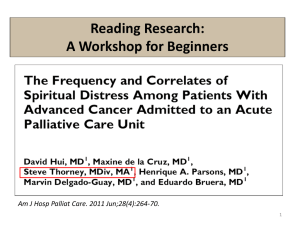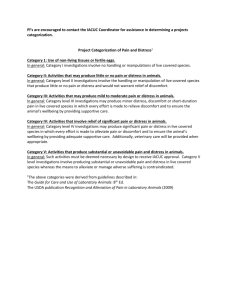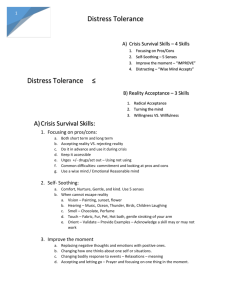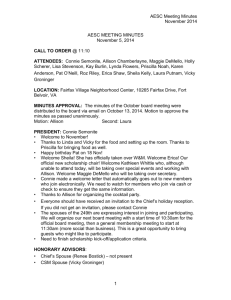Guidelines for animal use at Wits 2015
advertisement
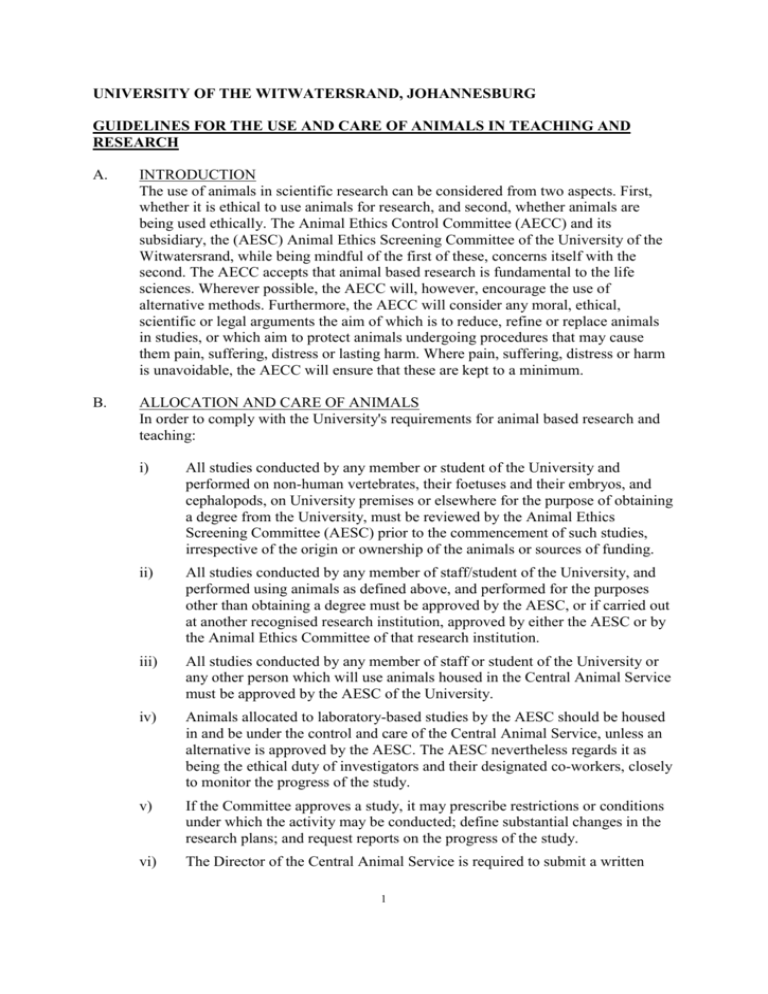
UNIVERSITY OF THE WITWATERSRAND, JOHANNESBURG GUIDELINES FOR THE USE AND CARE OF ANIMALS IN TEACHING AND RESEARCH A. INTRODUCTION The use of animals in scientific research can be considered from two aspects. First, whether it is ethical to use animals for research, and second, whether animals are being used ethically. The Animal Ethics Control Committee (AECC) and its subsidiary, the (AESC) Animal Ethics Screening Committee of the University of the Witwatersrand, while being mindful of the first of these, concerns itself with the second. The AECC accepts that animal based research is fundamental to the life sciences. Wherever possible, the AECC will, however, encourage the use of alternative methods. Furthermore, the AECC will consider any moral, ethical, scientific or legal arguments the aim of which is to reduce, refine or replace animals in studies, or which aim to protect animals undergoing procedures that may cause them pain, suffering, distress or lasting harm. Where pain, suffering, distress or harm is unavoidable, the AECC will ensure that these are kept to a minimum. B. ALLOCATION AND CARE OF ANIMALS In order to comply with the University's requirements for animal based research and teaching: i) All studies conducted by any member or student of the University and performed on non-human vertebrates, their foetuses and their embryos, and cephalopods, on University premises or elsewhere for the purpose of obtaining a degree from the University, must be reviewed by the Animal Ethics Screening Committee (AESC) prior to the commencement of such studies, irrespective of the origin or ownership of the animals or sources of funding. ii) All studies conducted by any member of staff/student of the University, and performed using animals as defined above, and performed for the purposes other than obtaining a degree must be approved by the AESC, or if carried out at another recognised research institution, approved by either the AESC or by the Animal Ethics Committee of that research institution. iii) All studies conducted by any member of staff or student of the University or any other person which will use animals housed in the Central Animal Service must be approved by the AESC of the University. iv) Animals allocated to laboratory-based studies by the AESC should be housed in and be under the control and care of the Central Animal Service, unless an alternative is approved by the AESC. The AESC nevertheless regards it as being the ethical duty of investigators and their designated co-workers, closely to monitor the progress of the study. v) If the Committee approves a study, it may prescribe restrictions or conditions under which the activity may be conducted; define substantial changes in the research plans; and request reports on the progress of the study. vi) The Director of the Central Animal Service is required to submit a written 1 report on any irregularities (where methods, procedures and restrictions deviate from those described in the protocol) relating to use of animals. Such reports will be investigated by the AESC. C. CONDUCT OF SCIENTIFIC PROCEDURES USING ANIMALS In order to ensure that the use of animals is ethical, the AECC through the AESC will: i) ensure that all proposed studies are classified (see D below) and that they comply with the University's ethical, legal and with the National Code (http://www.wits.ac.za/academic/researchsupport/19112/ethics_application_fo rms.html ) and scientific practices (See SOP links), for the handling and use of animals in research, education, diagnosis and testing of drugs and related substances in South Africa. ii) establish that investigators and co-workers who use animals, are appropriately qualified ( http://www.savc.org.za/act-rule-regulations-forms/policies/authorisation-all-veterinary-and-para-veterinary-services-section231c?showall=&limitstart= ) (see E below). iii) require whenever appropriate that all procedures which are likely to cause fear, pain, stress, or distress, be performed under anaesthesia where applicable. iv) require that animals be withdrawn from an experiment or be humanely killed whenever necessary (Endpoints 6.3.1.10 Page 27 SANS/humane methods of euthanasia 6.3.1.7 page 26 SANS nb document currently under revision). v) not allow animals which have been used for one study to be subjected to further studies unless: a it is a scientific necessity that the same animal be used in a series of regulated procedures for a particular purpose, ie a different animal could not equally well have been chosen for the second or subsequent procedure, eg the data generated in the second procedure is dependent on that generated from the first. or b the first or subsequent procedure was a minor one. In this context minor means that there were minimal anatomical or physiological sequelae as determined by clinical assessment. or c a surgically prepared animal is to be used for a subsequent procedure for which the surgical preparation is essential. or d the second intervention is a non-recovery (terminal) intervention. 2 D. CLASSIFICATION OF EXPERIMENTS The AESC will scrutinise all studies in which non-human vertebrates, vertebrate foetuses, vertebrate embryos and members of the class Cephalopods (e.g. squid) are to be used. All these animals have, or have the potential for developing, a nervous system capable of perceiving painful stimuli. The AESC will not scrutinise studies on other invertebrates, or micro-organisms. Applications will be classified according to the severity of each experiment/intervention. The severity of a procedure is determined by the degree of pain, suffering, distress or lasting harm expected to be experienced by the animal during the course of the procedure. The procedure consists of a combination of one or more technical acts carried out on an animal which may cause that animal pain, suffering, distress or lasting harm. The assignment of the severity category takes into account any intervention or manipulation of an animal within a defined procedure. The severity category shall be assigned based on the most severe effects likely to be experienced by an individual animal after applying all appropriate refinement techniques. The five categories of experiments are: Categories of invasiveness in animal experiments Category A. Non-recovery: Procedures, which are performed entirely under general anaesthesia from which the animal shall not recover consciousness. Category B. Mild: Procedures on animals as a result of which the animals are likely to experience short term mild pain, suffering or distress. Procedures with no significant impairment of the wellbeing or general condition of the animals. Examples: Pharmacokinetic study where a single dose is administered and a limited number of blood samples are taken (totalling < 10% of circulating volume) and the substance is not expected to cause any detectable adverse effect; Non-invasive imaging of animals (eg MRI) with appropriate sedation or anaesthesia; Superficial procedures, e.g. ear and tail biopsies, non surgical subcutaneous implantation of mini-pumps and transponders; Application of external telemetry devices that cause only minor impairment to the animals or minor interference with normal activity and behaviour; Administration of substances by subcutaneous, intramuscular, intraperitoneal routes, gavage and intravenously via superficial blood vessels, where the substance has no more vthan mild impact on the animal, and the volumes are within appropriate limits for the size and species of the animal; Induction of tumours, or spontaneous tumours, that cause no detectable clinical adverse effects (e.g. small, subcutaneous, non-invasive nodules); Breeding of genetically altered animals which is expected to result in a phenotype with mild effects; 3 Feeding of modified diets, that do not meet all of the animals' nutritional needs and are expected to cause mild clinical abnormality within the time-scale of the study; Short term (<24h) restraint in metabolic cages; Studies involving short-term deprivation of social partners, short-term solitary caging of adult rats or mice of sociable strains; Models which expose animals to noxious stimuli which are briefly associated with mild pain, suffering or distress, and which the animals can successfully avoid. Category C. Moderate: Procedures on animals as a result of which the animals are likely to experience short term moderate pain, suffering or distress, or long-lasting mild pain, suffering or distress. Procedures that are likely to cause moderate impairment of the wellbeing or general condition of the animals. Examples: Frequent application of test substances which produce moderate clinical effects, and withdrawal of blood samples (>10% of circulating volume) in a conscious animal within a few days without volume replacement; Acute dose-range finding studies, chronic toxicity / carcinogenicity tests, with non-lethal endpoints; Surgery under general anaesthesia and appropriate analgesia, associated with postsurgical pain, suffering or impairment of general condition. Examples include: thoracotomy, craniotomy, laparotomy, orchidectomy, lymphadenectomy, thyroidectomy, orthopaedic surgery with effective stabilisation and wound management, organ transplantation with effective management of rejection, surgical implantation of catheters, or biomedical devices (e.g. telemetry transmitters, minipumps, etc.); Models of induction of tumours, or spontaneous tumours, that are expected to cause moderate pain or distress or moderate interference with normal behaviour; Irradiation or chemotherapy with a sublethal dose, or with an otherwise lethal dose but with reconstitution of the immune system. Adverse effects would be expected to be mild or moderate and would be shortlived (<5 days); Breeding of genetically altered animals which are expected to result in a phenotype with moderate effects; Creation of genetically altered animals through surgical procedures; Use of metabolic cages involving moderate restriction of movement over a prolonged period (up to 5 days); Studies with modified diets that do not meet all of the animals’ nutritional needs and are expected to cause moderate clinical abnormality within the time-scale of the study; Withdrawal of food for 48 hours in adult rats; Evoking escape and avoidance reactions where the animal is unable to escape or avoid the stimulus, and are expected to result in moderate distress. Category D. Severe: Procedures on animals as a result of which the animals are likely to experience severe pain, suffering or distress, or long-lasting moderate pain, suffering or distress. Procedures which are likely to cause severe impairment of the wellbeing or general condition of the animals. Examples: Toxicity testing where death is the end-point, or fatalities are to be expected and severe pathophysiological states are induced. For example, single dose acute toxicity testing (see OECD testing guidelines); 4 Testing of a device where failure may cause severe pain, distress or death of the animal (e.g. cardiac assist devices); Vaccine potency testing characterised by persistent impairment of the animal’s condition, progressive disease leading to death, associated with long-lasting moderate pain, distress or suffering; Irradiation or chemotherapy with a lethal dose without reconstitution of the immune system, or reconstitution with production of graft versus host disease; Models with induction of tumours, or with spontaneous tumours, that are expected to cause progressive lethal disease associated with long-lasting moderate pain, distress or suffering. For example tumours causing cachexia, invasive bone tumours, tumours resulting in metastatic spread, and tumours that are allowed to ulcerate; Surgical and other interventions in animals under general anaesthesia which are expected to result in severe or persistent moderate postoperative pain, suffering or distress or severe and persistent impairment of the general condition of the animals. Production of unstable fractures, thoracotomy without adequate analgesia, or trauma to produce multiple organ failure; Organ transplantation where organ rejection is likely to lead to severe distress or impairment of the general condition of the animals (e.g. xenotransplantation); Breeding animals with genetic disorders that are expected to experience severe and persistent impairment of general condition, for example Huntington’s disease, Muscular dystrophy, chronic relapsing neuritis models; Use of metabolic cages involving severe restriction of movement over a prolonged period; Inescapable electric shock (e.g. to produce learned helplessness); Complete isolation for prolonged periods of social species e.g. dogs and non-human primates; Immobilisation stress to induce gastric ulcers or cardiac failure in rats; Forced swim or exercise tests with exhaustion as the end point. In some instances: Category 0. Studies or experiments on most invertebrates, or on non-entire living Material These include: tissues obtained at autopsy, necropsy or from the slaughterhouse; eggs (<50% development), protozoa and related single celled organisms; studies or experiments involving containment, incision or other invasive action on metazoa. Cephalopods and some other higher invertebrates have nervous systems as well developed as some vertebrates and therefore Categories of Invasiveness B, C and D may apply. E. CLASSIFICATION OF SKILLS The classification of studies allows the AESC to qualify the levels of care needed for each category of procedures and the level of technical skill required by researchers to do the experiments /intervention/observations. The AESC will endeavour to match the skills required to the category of experiment because this represents the best way of ensuring the proper use of animals. The skills required are set out in the table below. 5 Capacity of Experiment Recommended levels of care Minimum qualifications needed to do procedures 0 No peri- or post-experimental care required. On-the-job training. All students and researchers. A Standard husbandry and elementary clinical care. Researcher required to make regular observations for the duration of the experiment. Individuals authorised to perform veterinary procedures. Undergraduate and Masters students under supervision. Veterinarians, dentists, medical doctors with research skills or under supervision, or PhD graduate with proven specific clinical skills. National Dip Lab. Animal Science plus on-the-job training. B Standard husbandry and elementary clinical care. Researcher required to make regular observations for the duration of the experiment. A person registered with the SAVC for specific procedures, veterinarian, dentist, medical doctor with research skills or under supervision, or PhD with proven specific approved clinical skills. C Standard husbandry plus basic clinical care. Minimum qualification needed for care is Dip. Vet. Nur. and on-thejob training. Researcher or co-worker to make daily observations daily at regular intervals. A person registered with the SAVC for specific procedures, veterinarian, dentist, medical doctor with research skills or under supervision, or PhD with proven specific approved clinical skills. D Standard husbandry. Daily clinical care by a veterinary nurse under the direct supervision of a veterinarian. Researcher or designated co-worker to make daily observations until normal physiological mechanisms can maintain homeostasis, and at regular intervals thereafter. As above. Veterinarian, dentist, medical doctor with research skills or under supervision, or PhD with proven specific clinical skills. 6 F. GUIDELINES FOR THE USE OF ANIMALS IN THE TRAINING OF SURGICAL TECHNIQUES Applications for the use of animals for surgical training courses will normally only be approved under the following conditions; a) there is clear and obvious benefit to the surgeon, in terms of developing his/her surgical skills. b) there is no better alternative available (this will require a motivation by the applicant). c) only dead or fully anaesthetised animals which do not recover from the anaesthesia will be used in the course. d) no course will be approved which is run primarily for commercial benefit (profit) either to the organizers of the course or to any commercial entity involved with the course (e.g. a company which provides equipment for the course). In addition to the above conditions, the AESC will expect that; 1. the course will be in keeping with the role of the University to provide training essential for Health Professionals. 2. in general approved courses will focus on development of essential clinical expertise. 3. no course will be organized prior to AESC approval and liaison with the Director of the CAS 4. a Memorandum of Understanding to be signed by both parties (Wits and the company involved) 5. the financial aspects of training courses will be transparent and subject to full disclosure to the Research Office of the University G. RESPONSIBILITIES OF RESEARCHERS RELATED TO ANIMAL CARE and USAGE To ensure optimal care of animals housed within the CAS together with promoting efficient administrative procedures, researchers should: i) order animals timeously and inspect them when they arrive at CAS or when they are allocated to a study from CAS stocks. ii) weigh animals regularly, as this is an important indicator of general wellbeing and any animal which loses 15% or more of it’s body weight is to be removed from the experiment; this restriction does not apply to pregnant animals or reptiles. iii) discuss any special requirements with a senior CAS staff member, particularly if a change to normal husbandry procedure is envisaged. iv ) v) arrange for themselves or an appropriate delegate be in attendance for the duration of surgery carried out on their behalf by CAS staff. familiarize themselves with CAS standing operating procedures (see links to SOP files) and relevant documentation, (especially with respect to the booking 7 of surgical/technical support and completion of “termination of study” forms) and to relate these procedures to co-workers involved in the projects (especially students). vi) vii) regularly read the “bed-letter” and record any procedure/intervention/ observation as this is an efficient means of updating project progress and communication with CAS staff. at all times adhere to the protocol, get approval for any changes to the protocol and report any deviations or transgression from the approved protocol. H: CLINICAL CARE OF ANIMALS As prescribed by the National Code, the veterinarians appointed by the University have ultimate authority over the clinical care of animals, and can withdraw any animal from an experiment at any time for clinical reasons. The Veterinarian may recommend termination of a study in consultation with members of the AESC. November 2014 /ae/guidelines 8




